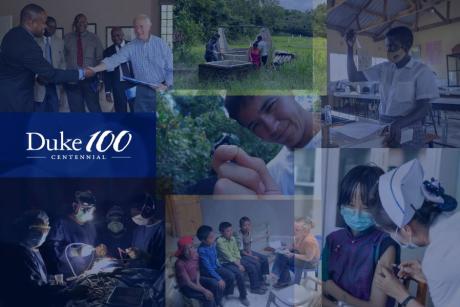Drs. Wilkinson and Hayat report on their first month in Tanzania.
In the first month after his arrival in Moshi, Tanzania to launch the Duke-KCMC Women’s Reproductive Health Program, DGHI Member Jeff Wilkinson found himself participating in the examinations for residents and medical students at Kilimanjaro Christian Medical Centre (KCMC).
“It seemed somewhat surreal walking around the wards testing medical students and residents on patient conditions and resource limitations that are merely theoretical at Duke, but in your face here in Tanzania,” he reports in his blog. “The students and residents had a superb command of the theory behind optimal treatment for these conditions, but limited experience with employing this therapy because of the resource limitations. The effects of poverty are pervasive and have a direct impact on women and their families.”
Wilkinson describes caring for patients on a unit that has up to 2 people in each bed. “There was one patient with eclampsia and intrauterine fetal death, an all too common occurrence here where access to care is often either delayed or not available at all. There were a number of women with HIV, most notably one who had AIDS and probably pneumocystitis at 20 weeks gestation. She suffered for weeks before arriving at KCMC for care and was slowly improving on the unit after initiation of antiretroviral medications. Another woman presented in heart failure, severe anemia and fever at 28 weeks pregnancy. Her anemia was almost certainly from her poor nutritional status and her acute illness from malaria. ”
In addition to complications of pregnancy, Tanzanian women also suffer greatly from cervical cancer because of lack of screening. Wilkinson describes a 47-year old patient who, “had she lived in Durham would likely have undergone screening by pap smear and would be cured of dysplasia 5 or more years ago, but now lies in bed with stage 3 cervical cancer waiting to die from obstructive uropathy.”
Sumera Hayat, MD, uses the blog to describe her experience of the Antenatal clinic. “Except for people speaking Swahili, I felt like I could have been back in a Prenatal Clinic at any North Carolina health department. Instead of individual exam rooms, elegantly embroidered curtains separate patient tables. The patient has to travel a bit through the hospital before being seen in the clinic. The hospital hallways are like a maze, somewhat resembling Duke South. Patients first present to the clinic, so the doctor or nurse can sign their appointment card for the day- this allows the patient to go to Medical Records, to pay ~$1 to have their file pulled. If you have never been seen at the hospital before, it costs ~$4 to get a file created (about a day’s wage for a non-skilled worker),” she says.



